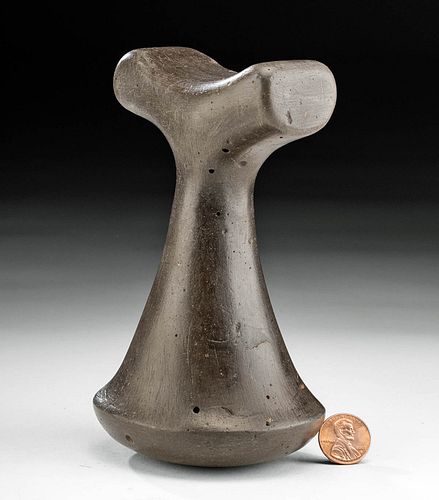19th C. Tahitian Volcanic Stone Pounder
Lot 106a
About Seller
Artemis Fine Arts
686 S Taylor Ave, Ste 106
Louisville, CO 80027
United States
Selling antiquities, ancient and ethnographic art online since 1993, Artemis Gallery specializes in Classical Antiquities (Egyptian, Greek, Roman, Near Eastern), Asian, Pre-Columbian, African / Tribal / Oceanographic art. Our extensive inventory includes pottery, stone, metal, wood, glass and textil...Read more
Categories
Estimate:
$3,000 - $4,500
Absentee vs Live bid
Two ways to bid:
- Leave a max absentee bid and the platform will bid on your behalf up to your maximum bid during the live auction.
- Bid live during the auction and your bids will be submitted real-time to the auctioneer.
Bid Increments
| Price | Bid Increment |
|---|---|
| $0 | $25 |
| $300 | $50 |
| $1,000 | $100 |
| $2,000 | $250 |
| $5,000 | $500 |
| $10,000 | $1,000 |
| $20,000 | $2,500 |
| $50,000 | $5,000 |
| $100,000 | $10,000 |
| $200,000 | $20,000 |
About Auction
By Artemis Fine Arts
Nov 12, 2020
Set Reminder
2020-11-12 12:00:00
2020-11-12 12:00:00
America/New_York
Bidsquare
Bidsquare : Arms & Armor | Antiquity to Modern Day
https://www.bidsquare.com/auctions/artemis-gallery/arms-armor-antiquity-to-modern-day-6023
Specialty auction featuring axes, mace heads, swords, spears, various types of armor, and more! Many different cultures and price ranges. Great for first-time buyers, seasoned collectors, dealers, and that hard to buy for person on your holiday shopping list. Artemis Fine Arts info@artemisfinearts.com
Specialty auction featuring axes, mace heads, swords, spears, various types of armor, and more! Many different cultures and price ranges. Great for first-time buyers, seasoned collectors, dealers, and that hard to buy for person on your holiday shopping list. Artemis Fine Arts info@artemisfinearts.com
- Lot Description
South Pacific, French Polynesia, Tahiti, ca. late 19th century CE. Skillfully carved from a volcanic stone of a rich dark chocolate brown hue, a pounder of a cross-bar type which is the classical Maupiti form (as opposed to having a forked top or a faceted top). The long cylindrical handle gradually widens to a broad, rounded pounding surface. These pounders were used to create a paste from the pulp of fruits and edible roots, usually bread-fruit and taro, by crushing them on a stone or wooden surface of a plateau-like form, oftentimes on four feet, known as a papahia or 'umete. The resulting mash was then fermented and called mahi by the Tahitians, though the Hawaiian term "poi" is perhaps better known. Size: 3.3" (diameter of pounding surface) x 5.625" H (8.4 cm x 14.3 cm)
Poi pounders, alongside adzes, were the most important stone tools in Polynesia and the Hawaiian Islands (Europeans introduced steel weapons). Traditional calabash bowls were used as containers to hold poi mixtures, and traveling royalty were accompanied by their own poi maker, with his or her own poi-making implements such as this fine example.
Provenance: private Whitestone, New York, USA collection inherited from father 1995
All items legal to buy/sell under U.S. Statute covering cultural patrimony Code 2600, CHAPTER 14, and are guaranteed to be as described or your money back.
A Certificate of Authenticity will accompany all winning bids.
We ship worldwide and handle all shipping in-house for your convenience.
#159728Expected surface wear with a few divots, chips, scuffs, and abraded areas as well as a few holes that are probably inherent to the stone. Otherwise intact and superb.Condition
- Shipping Info
-
All shipping is handled in-house for your convenience. Your invoice from Artemis Gallery will include shipping calculation instructions. If in doubt, please inquire BEFORE bidding for estimated shipping costs for individual items.
-
- Buyer's Premium



 EUR
EUR CAD
CAD AUD
AUD GBP
GBP MXN
MXN HKD
HKD CNY
CNY MYR
MYR SEK
SEK SGD
SGD CHF
CHF THB
THB















